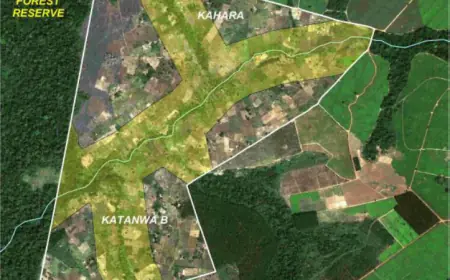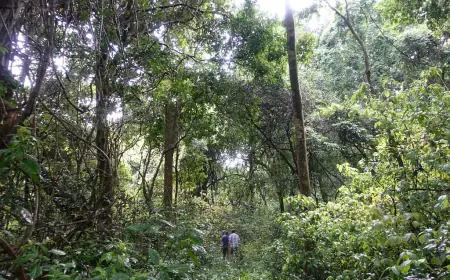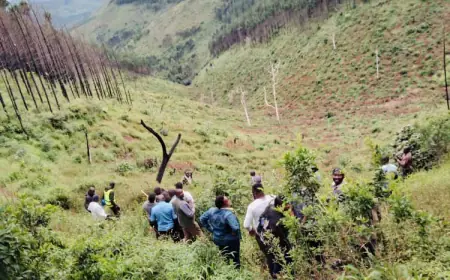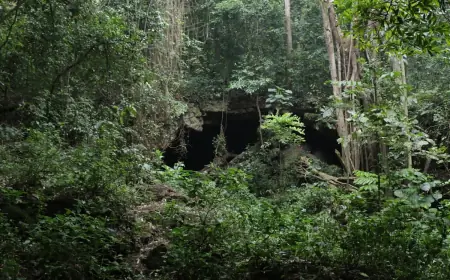Mpanga Central Forest Reserve
Mpanga Central Forest Reserve was originally part of a larger forest that extended from Lake Victoria to the west. However, due to human activities such as agriculture, logging, and settlement, the forest was gradually reduced to its current size.
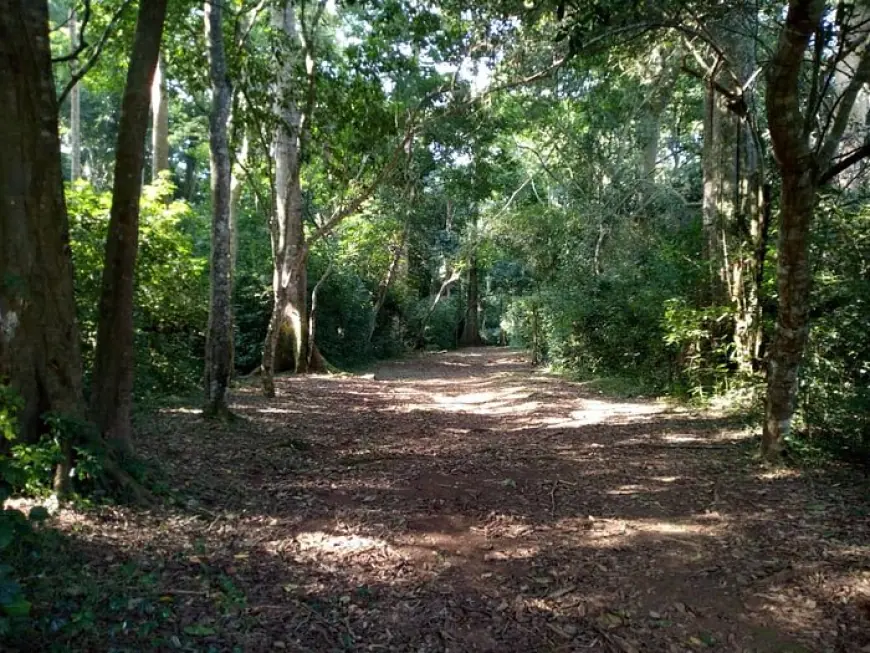
Imagine walking through a lush green forest, listening to the sounds of birds, monkeys, and insects. Imagine feeling the fresh air, smelling the earthy aroma, and seeing the sunlight filtering through the canopy. Imagine discovering a variety of plants, animals, and insects that are unique to this ecosystem. This is what you can experience at Mpanga Central Forest Reserve, a small patch of natural equatorial rainforest in Uganda.
Mpanga Central Forest Reserve is one of the closest natural forests to Kampala, the capital city of Uganda. It is located in Mpigi District, Mpambire, about 37 kilometers southwest of Kampala. It covers an area of 453 hectares (1,120 acres) and supports an impressive biodiversity for such a small forest. It has 500 species of trees and shrubs, 300 species of birds, 97 butterflies, and 112 moths. It also hosts three species of monkeys, namely vervet, red-tailed, and black and white colobus monkeys, as well as other small mammals such as banded mongoose, squirrels, pottos, pangolins, and bushabies.
Mpanga Central Forest Reserve is not only a natural wonder but also a historical and cultural treasure. It has been protected by the government of Uganda as a scientific research site since 1953. It was named after a wealthy family that owned the land before it was gazetted as a forest reserve. It is surrounded by a community of traditional drum makers who use the soft trees from the forest to make their drums. It is also a place where local people collect firewood, charcoal, and medicinal herbs from the forest.
In this article, we will explore the history, ecology, and activities of Mpanga Central Forest Reserve and why it is a hidden gem of Uganda that deserves more attention and appreciation.
History
Mpanga Central Forest Reserve was originally part of a larger forest that extended from Lake Victoria to the west. However, due to human activities such as agriculture, logging, and settlement, the forest was gradually reduced to its current size. The forest was first gazetted as a forest reserve in 1932 and then as a scientific research site in 1953. The main purpose of the research site was to study the effects of selective logging on the forest structure and regeneration. The research was conducted by the Forest Department of Uganda in collaboration with the Commonwealth Forestry Institute of Oxford University. The research site was divided into four blocks, each with a different logging intensity, ranging from no logging to heavy logging. The research lasted until 1972, and the results showed that selective logging had a negative impact on forest diversity and productivity.
Since then, Mpanga Central Forest Reserve has been managed by the National Forestry Authority of Uganda, with the aim of conserving the forest and its biodiversity, as well as providing environmental education and ecotourism services to the public. The forest is also used by local universities and schools for teaching and research purposes. The forest is fenced and guarded by rangers to prevent illegal activities such as poaching, encroachment, and fire. The forest is also monitored and inventoried regularly to assess its health and status.
Ecology
Mpanga Central Forest Reserve is a typical example of a tropical, moist evergreen forest with a high diversity of plant and animal species. The forest has four layers of vegetation: the emergent layer, the canopy layer, the understory layer, and the forest floor layer. The emergent layer consists of the tallest trees that reach up to 40 meters in height, such as Celtis, Milicia, and Funtumia. The canopy layer is the most dense and diverse layer, with trees ranging from 20 to 30 meters in height, such as Albizia, Antiaris, and Maesopsis. The understory layer is the lowest layer of trees, with heights of 10 to 15 meters, such as Macaranga, Musanga, and Trema. The forest floor layer is the layer of herbs, shrubs, ferns, and grasses that grow in the shade of the trees, such as Impatiens, Asystasia, and Cyperus.
The forest is home to a rich fauna, especially birds and primates. The forest has 300 species of birds, representing 40% of the total bird species in Uganda. Some of the notable birds include the great blue turaco, the Ross's turaco, the grey parrot, the African grey hornbill, the black-and-white casqued hornbill, the narina trogon, the blue-breasted kingfisher, the African green pigeon, the African emerald cuckoo, the yellow-throated tinkerbird, the yellow-rumped tinkerbird, the yellow-spotted barbet, the hairy-breasted barbet, the yellow-billed barbet, the green hylia, the green crombec, the grey-backed camaroptera, the white-browed robin-chat, the red-capped robin-chat, the olive sunbird, the collared sunbird, the green-headed sunbird, the green-throated sunbird, the purple-banded sunbird, the bronze sunbird, the superb sunbird, the black-headed weaver, the black-necked weaver, the orange weaver, the brown-throated weaver, the yellow-backed weaver, the yellow-mantled weaver, the red-headed malimbe, the grey-headed negrofinch, and the red-headed bluebill.
The forest also has three species of monkeys, namely the vervet monkey, the red-tailed monkey, and the black and white colobus monkey. The vervet monkey is the most common and widespread monkey in the forest, and it can be seen in groups of up to 20 individuals. The red-tailed monkey is the smallest and most elusive monkey in the forest and can be seen in small groups of up to 10 individuals. The black and white colobus monkey is the largest and most conspicuous monkey in the forest and can be seen in groups of up to 15 individuals. The monkeys feed on fruits, leaves, flowers, and insects and play an important role in seed dispersal and pollination in the forest.
Other small mammals that can be found in the forest include the banded mongoose, the squirrel, the pottos, the pangolin, and the bushbaby. The banded mongoose is a social and diurnal animal that lives in groups of up to 20 individuals. The squirrel is a solitary and arboreal animal that feeds on nuts, seeds, and fruits. The potto is a nocturnal and slow-moving animal that feeds on fruits, leaves, and insects. The pangolin is a nocturnal and secretive animal that feeds on ants and termites. The bushbaby is a nocturnal and agile animal that feeds on fruits, insects, and gum. These animals are often difficult to spot but can be heard by their distinctive sounds at night.
The forest also has a variety of insects, especially butterflies and moths. The forest has 97 species of butterflies and 112 species of moths, some of which are endemic to the forest. Some of the notable butterflies include the African giant swallowtail, the emperor swallowtail, the mocker swallowtail, the forest queen, the African monarch, the blue pansy, the forest mother-of-pearl, the forest commodore, the African leopard, the African map, the African snout, the African leaf butterfly, the African cracker, the African swordtail, the African policeman, the African charaxes, the African nymph, the African satyr, the African skipper, and the African lycaenid. Some of the notable moths include the African moon moth, the African emperor moth, the African luna moth, the African hawk moth, the African tiger moth, the African silk moth, the African sphinx moth, the African owlet moth, the African noctuid moth, and the African geometrid moth. These insects are attracted by the flowers, fruits, and sap of the plants and provide food for birds and other animals.
Activities
Mpanga Central Forest Reserve offers a range of activities for visitors who want to enjoy the beauty and diversity of the forest. The activities are divided into two main categories: forest activities and leisure activities.
Forest Activities
Forest activities are those that involve exploring the forest and its wildlife. The forest has four well-developed trails that suit different interests and abilities: the Baseline Trail, the Hornbill Trail, the Butterfly Trail, and the Racing Trail. The Baseline Trail is the shortest and easiest trail, covering 1 km and taking about 30 minutes. It follows the original baseline that was used for scientific research in the 1950s and passes through different vegetation types and logging intensities. The Hornbill Trail is the longest and most challenging trail, covering 10 km and taking about 4 hours. It follows the boundary of the forest reserve and offers the best chance of seeing the hornbills and other birds. The Butterfly Trail is the most scenic and diverse trail, covering 5 km and taking about 2 hours. It passes through the core of the forest and offers the best chance of seeing the butterflies and other insects. The Racing Trail is the most adventurous and exciting trail, covering 3 km and taking about 1 hour. It is designed for dirt biking, mountain biking, hiking, and running, and passes through some of the steepest and roughest parts of the forest.
The forest activities also include nature walks, bird watching and identification, primate watching, butterfly identification, and camping. Nature walks are guided by trained and knowledgeable guides who explain the history, ecology, and culture.
Leisure Activities
Leisure activities are those that involve relaxing and enjoying the facilities and services of the forest reserve. The forest has a well-equipped visitor center that provides information, maps, guides, souvenirs, snacks, and drinks. The visitor center also has a conference hall that can accommodate up to 50 people and can be used for meetings, workshops, seminars, and events. The forest also has a picnic site that has tables, chairs, benches, and a barbecue area. The picnic site is ideal for family outings, group gatherings, and parties. The forest also has a campsite that has tents, mattresses, blankets, and a fire pit. The campsite is perfect for overnight stays, camping, and bonfires. The forest also has a playground that has swings, slides, seesaws, and a climbing wall. The playground is suitable for children and adults who want to have some fun and exercise.
The leisure activities also include drum making, cultural dances, storytelling, and community visits. Drum making is a traditional craft that is practiced by the local drum makers who live around the forest. The drum makers use the soft trees from the forest, such as Musanga and Ficus, to make their drums. The drums are used for music, ceremonies, and rituals. The drum makers can teach visitors how to make their own drums and sell them at a reasonable price. Cultural dances are performed by the local dancers, who showcase their skills and talents. The dances are accompanied by the drums and other instruments, such as flutes, rattles, and bells. The dances are expressive, energetic, and colorful and reflect the culture and history of the people. Storytelling is done by the local elders, who share their stories and legends about the forest and the community. The stories are informative, entertaining, and inspiring, and they teach valuable lessons and morals. Community visits are organized by the local guides, who take visitors to the nearby villages and homes. Community visits are a great way to interact with the local people, learn about their lifestyle, and support their livelihood.
Conclusion
Mpanga Central Forest Reserve is a hidden gem of Uganda that offers a unique and memorable experience for visitors who love nature, culture, and adventure. The forest is a biodiversity hotspot that hosts a variety of plants and animals, some of which are endemic to the forest. The forest is also a historical and cultural treasure that has been protected and preserved for scientific research and education. The forest offers a range of activities for visitors who want to explore the forest and its wildlife or relax and enjoy the facilities and services of the forest reserve. The forest is easily accessible from Kampala and is open to the public throughout the year. Mpanga Central Forest Reserve is a place that deserves more attention and appreciation and is a must-visit destination for anyone who visits Uganda.
What's Your Reaction?
 Like
0
Like
0
 Dislike
0
Dislike
0
 Love
0
Love
0
 Funny
0
Funny
0
 Angry
0
Angry
0
 Sad
0
Sad
0
 Wow
0
Wow
0





























































